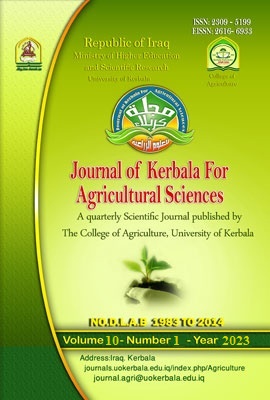Studying the relationship between advanced oxidative stress of protein and uterine disturbance in dairy cows
DOI:
https://doi.org/10.59658/jkas.v10i3.1116Keywords:
protein oxidation, merits, sub clinical meritsAbstract
The study was conducted on 100 dairy cows in Tag-Alnahrain station, located in Al-Qadysia province, post parturition (after 40-60) days after calving. The aim of the study was to test the relationship between oxidative stress, particularly protein oxidation, and uterine health during the puerperium. The cows are divided into four groups according to intense clinical sighs of merit. In order to distinguish between degrees of inflammation, in this study, the cutoff value of PMN %. was set at 8% to distinguish between degrees of inflammation. The group (H) was (54). The SCE group consisted of 22 cows infected with subclinical endometritis, the EM1 group consisted of 11 cows infected with clinical endometritis Grade 1, and the EM2 group consisted of 13 cows infected with clinical endometriosis Grade 2. The advanced oxidation protein product (AOPP) was estimated in plasma and vaginal mucus discharges by using a commercial laboratory method to detect the dityrosin formation, which is the major content of AOPP. AOPP, a good marker of protein oxidation, was visualised by western blot,. The study demonstrated that there was an increase in plasma AOPP in the EM2 group with a significant value of p 0.01.The study also showed a significantly increased concentration of AOPP in vaginal mucus discharges in the group of animals infected with (SCE). The study clarified that there was an increase in neutrophil point age of more than 8% in vaginal mucus discharge after collecting mucus by metrecheek in the (EM1) group with a significant value of p≤0.0l while it was significantly(p≤0.01) in uterine mucus collected by cytobrush.
Downloads
Published
How to Cite
Issue
Section
License
Copyright (c) 2023 Copyright (c) 2024 is the Author's article. Published by the Journal of Kerbala for Agricultural Sciences under a CC BY 4.0 license

This work is licensed under a Creative Commons Attribution 4.0 International License.
Licensing Terms
All articles are published under a Creative Commons License and will be directed to the Creative Commons Attribution 4.0 International License (CC BY 4.0) That permits use, distribution, and reproduction in any medium, provided the original work is properly cited. This license also allows the work to be used for commercial purposes.
Use by both non-commercial and commercial users
This content is licensed under a Creative Commons Attribution 4.0 International (CC BY 4.0) license, permitting use by both non-commercial and commercial users. Individual users may access, download, copy, display, and redistribute the articles to colleagues, as well as adapt, translate, and text- and data-mine the content, subject to the following conditions:
- The author's moral rights, including the right of attribution and the right to protect their work from derogatory treatment, are respected.
- Where content in the article is identified as belonging to a third party, users must ensure that any reuse complies with the copyright policies of the owner of that content.
- If the article content is reused for research or educational purposes, users should maintain a link to the appropriate bibliographic citation, including the DOI and a link to the published version on the journal's website.






